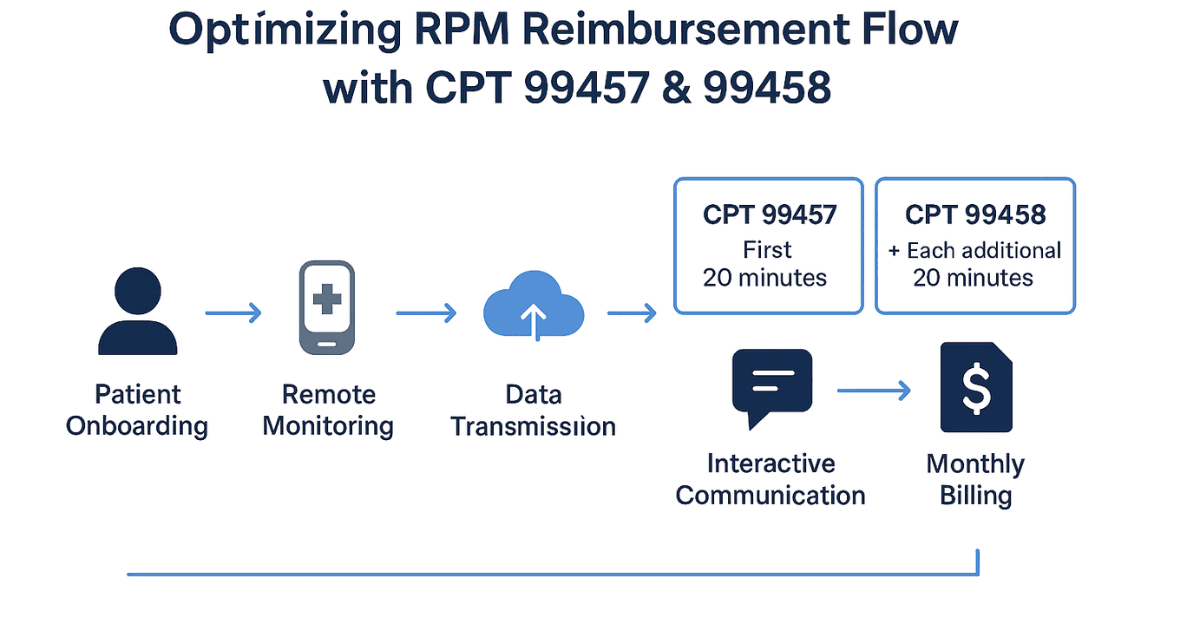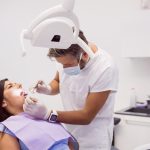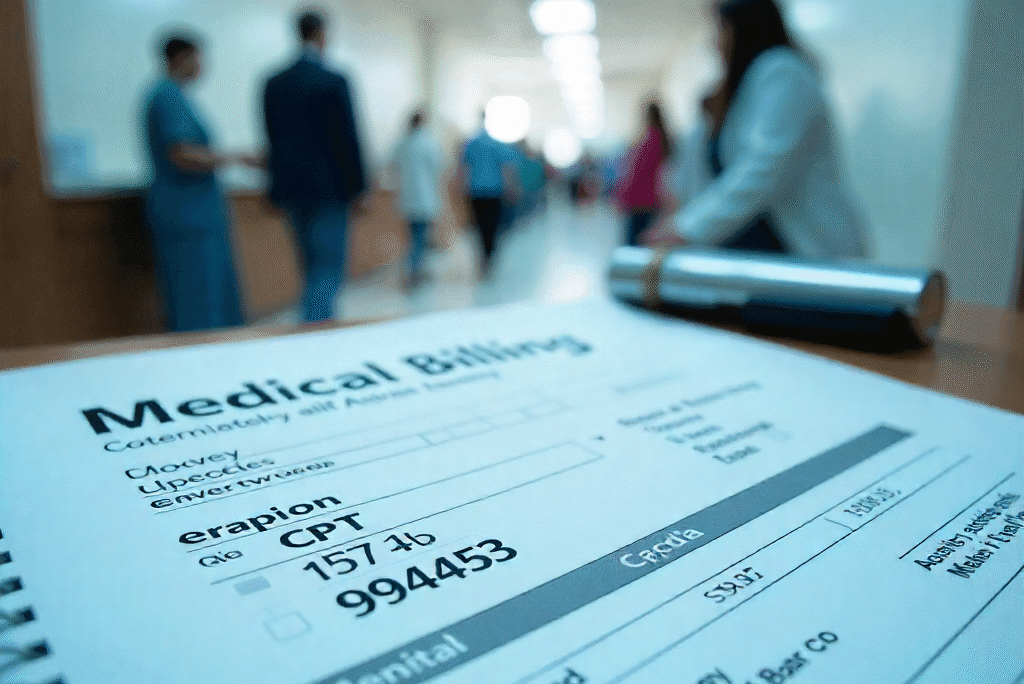Mastering CPT Code 99453: Physician Guide to Seamless RPM Activation
Remote Patient Monitoring (RPM) has become essential within modern healthcare. It extends clinical oversight outside office visits, improving patient outcomes. Effectively activating RPM programs is critical for both patient care and practice viability. CPT code 99453 forms the cornerstone about initial RPM setup and patient education. This guide offers physicians, specialty practices, and clinics a look toward operational challenges and revenue opportunities.
Understanding CPT Code 99453: Device Setup & Patient Education
Integrating RPM requires a clear grasp onto its foundational billing. CPT 99453 is the first step along this process. Physicians must ensure proper setup and comprehensive patient education.
What is CPT Code 99453? A Clear Description
CPT code 99453 covers initial setup for RPM device(s) and patient education about their use. This code accounts for the time and resources spent in onboarding a patient into an RPM program. Qualifying devices are FDA-defined medical devices capable for automatic data transmission. These include blood pressure cuffs, glucometers, pulse oximeters, and weight scales. This initial service ensures patients can effectively use their devices.
The Critical Role of Patient Education in RPM Success
Comprehensive patient education is vital. It extends beyond billing toward impact adherence and clinical outcomes directly. Effective education details device operation and data transmission. It also covers understanding alerts and contact protocols. Patients must grasp the importance for consistent use. Instructions should be clear, concise, and accessible for diverse patient demographics. A well-educated patient is more likely in engage with the program.
Key Requirements for Billing CPT 99453
CPT 99453 is a non-time-based code. It requires at least 16 days of data transmission from the device within a 30-day period. This requirement often links onto CPT 99454 (monthly device supply). CMS guidelines generally allow billing 99453 once per patient on episode of care. Documented patient consent is also mandatory before initiation. This consent should clearly outline the RPM program’s scope.
RPM/CCM Compliance Essentials
| Requirement | Actionable Step for Compliance | Why it Matters |
|---|---|---|
| Patient Consent | Obtain written or verbal consent; document thoroughly. | Ensures patient understanding and legal compliance. |
| FDA-Cleared Device | Use only devices meeting FDA medical device definitions. | Guarantees reliability and eligibility of reimbursement. |
| Patient Education | Conduct a personalized, interactive onboarding session. | Drives patient adherence and accurate data collection. |
| 16-Day Data Rule | Implement tools for track daily data transmission. | Crucial for billing eligibility for 99453 and subsequent codes. |
Navigating CPT Code 99453 Reimbursement & Compliance
Understanding reimbursement specifics and compliance rules is paramount. This prevents denials and maximizes revenue. Physicians must stay current about CMS guidelines and best practices.
CPT Code 99453 Reimbursement: What to Expect
The average national reimbursement for CPT 99453 for Medicare in 2025 is approximately $19.73. Geographic adjustments and payer contracts can affect this rate. While 99453 covers initial setup, it often precedes monthly RPM services. These include CPT 99454 (device supply), 99457 (initial 20 minutes of monitoring), and 99458 (additional 20 minutes). It is a distinct service.
CMS Guidelines: Avoiding Denials for CPT Code 99453
CMS specifies that 99453 is billable “once for episode of care.” This means one billing instance per patient for a given condition being monitored. Re-billing is generally only permitted if a patient is discharged and re-enrolled for a new episode of care with new device setup. Differentiating 99453 from other RPM codes (99454, 99457, 99458) is key toward preventing incorrect bundling or unbundling. “Incident to” billing rules allow clinical staff support under general physician supervision. This enables efficient delegation inside the practice.

Optimizing RPM Onboarding: Clinical & Operational Best Practices
Effective patient onboarding drives RPM program success. Smooth clinical and operational workflows minimize roadblocks. Technology can significantly enhance this process.
Streamlining Patient Onboarding Workflows
Efficient patient enrollment and device distribution are crucial. In-person or synchronous virtual setup for initial device training is highly effective. These sessions ensure patients grasp device usage and data transmission. Strategies for patient engagement from day one are vital. This ensures consistent data transmission and compliance with the 16-day rule. Proactive communication and support foster patient adherence.
Leveraging Technology for Enhanced Patient Activation
Intuitive RPM platforms and companion apps improve both physician usability and patient adherence. Automated prompts and reminders encourage patients to take readings consistently. Integration with EHR systems streamlines patient data flow and documentation. This reduces administrative burden on clinical staff. Efficient technology ensures data is captured and accessible. This supports timely clinical decision-making.
Proactive Troubleshooting: Minimizing RPM Activation Roadblocks
Anticipate common challenges on RPM activation. These include patient tech illiteracy, connectivity issues, and device malfunctions. Provide accessible technical support and clear escalation paths. Selecting reliable, user-friendly RPM devices and platforms minimizes these issues. A robust support infrastructure is essential for long-term patient engagement.
Financial & Operational Impact of Effective CPT 99453 Utilization
Proper utilization of CPT 99453 extends beyond initial setup. It impacts the financial health and operational efficiency of an RPM program. Strategic implementation can maximize revenue and enhance patient outcomes.
Maximizing Revenue Potential with Correct CPT 99453 Use
Correct activation via 99453 directly impacts downstream billing for monthly RPM services. This includes CPT 99454, 99457, and 99458. High patient engagement, seeded by good onboarding, ensures consistent data transmission. This leads toward eligible claims and sustained revenue. Each successful 99453 claim lays the groundwork for recurring monthly revenue.
Data-Driven Insights: Measuring RPM Activation Success
Key performance indicators (KPIs) measure RPM program success related with 99453. Track patient activation rates and 16-day data compliance. Monitor initial billing success rates for 99453. Analytics from your RPM solution can inform process improvements. These insights help optimize onboarding workflows and patient support.
Average 16-Day Data Compliance Rate (Initial 3 Months)
Integrating RPM into Value-Based Care Models
Successful RPM activation contributes towards better patient outcomes. This includes reduced readmissions and improved chronic disease management. These outcomes are crucial for performance in value-based care agreements. They can lead toward potential bonus payments and shared savings. RPM supports a proactive, preventive approach toward patient health.
Conclusion
Mastering CPT code 99453 is foundational. It ensures the successful launch and sustainability of any RPM program. Seamless activation offers multiple benefits. It leads toward improved patient care, optimized workflows, and robust revenue streams. Physicians and practices seeking comprehensive RPM and revenue cycle management solutions can explore SmartCare360.health. SmartCare360 provides the tools for enable these successes.
FAQ's
No, CPT 99453 is billable once for a patient for an episode of care. This applies regardless of the number of devices provided or conditions monitored within that episode.
Yes, the Centers for Medicare & Medicaid Services (CMS) generally require at least 16 days of data transmission inside a 30-day period for CPT 99453 to be billable. This aligns with requirements for CPT 99454.
Practices integrate Remote Patient Monitoring Solutions data directly into EHRs through interoperable platforms. This streamlines documentation. It automates charge capture. It provides a centralized view of patient data and billing information. Integration reduces manual data entry, minimizes errors, and supports efficient claim submission.
If a patient fails to transmit data for at least 16 days in the 30-day period following device setup, CPT 99453 may not be billable. Consistent patient engagement is crucial for reimbursement.
CPT 99453 covers the initial setup and education. CPT 99454 covers the monthly device supply and data transmission (requiring 16 days of data). CPT 99457 and 99458 cover monthly clinical monitoring time. All are distinct but often billed in sequence.












